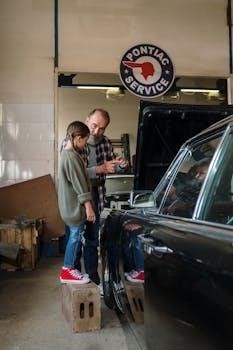The Hossfeld bender is a versatile machine, renowned for its ability to perform various bending operations. Manuals for the Model No. 2 are widely available, detailing its operation and parts. These manuals are crucial for understanding the bender’s capabilities and proper usage, ensuring safe and effective bending.
Overview of the Hossfeld No. 2 Bender
The Hossfeld No. 2 Bender is a standard rotary-draw bender, designed for a wide range of bending applications. It is capable of handling tube, pipe, flat, bar, square, and rectangular stock, as well as angle iron. This model is considered the original and is highly regarded for its accuracy and versatility. The No. 2 bender is designed so that the dies are easily interchangeable, which increases its usability. Furthermore, users can add a hydraulic power attachment to the bender when working with heavier materials. The instruction manual for the No. 2 bender is an essential resource, providing detailed instructions for its setup, operation, and maintenance.

Hossfeld Bender Manuals
Hossfeld bender manuals are essential for proper use and maintenance. These manuals, often including parts lists and instructions, provide detailed guidance for various models, ensuring safe and effective operation.
Availability of Manuals for Different Models
Manuals for various Hossfeld bender models, including the popular No. 2, are often available as digitally enhanced copies or reprints. These resources cater to different versions, such as the wrenchless type, ensuring users have the correct information. Manuals can be found through industrial machinery manual providers, often offering bound copies for durability. The availability of these manuals is important because they provide users with specific instructions for their particular bender model, covering aspects like parts lists and operational procedures. Different models require different tooling and setup, so these manuals are essential.
Content of Instruction Manuals
Instruction manuals for Hossfeld benders typically contain detailed information vital for safe and effective operation. These manuals include instructions on mounting the bender, general operating procedures, and specific details on hydraulic power attachments, if applicable. They also have comprehensive parts lists, functional illustrations, and schematics, aiding in maintenance and troubleshooting. The manuals often cover various models, outlining the specific features of each. Users rely on these manuals to understand proper setup, tooling usage, and safety precautions. Therefore, the content of these manuals is essential for optimal performance and longevity of the bender.

Hossfeld Bender Operation
Operating a Hossfeld bender involves careful setup and adherence to procedures detailed in the instruction manual. These manuals provide guidance on mounting, general operation, and the use of hydraulic attachments.
Mounting and Setup Instructions
Proper mounting is critical for safe and accurate operation of the Hossfeld bender, as highlighted in the instruction manuals. The manuals often contain specific diagrams and instructions for securing the bender to a stable workbench or base. Ensuring the bender is firmly mounted prevents movement during operation, which can lead to inaccurate bends or potential hazards. Detailed steps on how to correctly align and bolt down the machine are provided, alongside recommended torque specifications for fasteners. These manuals emphasize the importance of verifying that all connections are secure before commencing any bending procedures. Understanding these instructions is essential for a safe and effective workflow.
General Operating Procedures
The Hossfeld bender manuals provide essential guidance on general operating procedures, covering everything from material handling to die selection. These manuals detail how to properly load and secure stock material before bending, ensuring accurate and consistent results. Understanding the correct sequence of operations is vital for achieving the desired bends. Furthermore, they outline the safe use of the machine’s levers and handles, emphasizing controlled movements to avoid accidents. The manuals also include warnings about potential hazards, encouraging operators to wear safety equipment and follow specified procedures when using the bender. These instructions, when followed, can contribute to a safer and more efficient work environment.
Bending Capabilities
The Hossfeld bender, as detailed in its manuals, can bend various materials like flat stock, bar, and tube. It offers diverse bending options, including angles, U-bends, and offsets, with the right tooling.
Bending Different Materials
The Hossfeld bender’s versatility is highlighted in its ability to bend a wide range of materials, as outlined in its instruction manuals. These manuals often provide detailed guidance on handling various types of stock, including flat bar, solid round bar, tubing, and angle iron. The specific procedures and tooling required for each material are clearly explained, emphasizing the importance of proper setup for accurate and consistent results. Instruction manuals often include charts and tables specifying the bending limits and recommended tooling for different materials and sizes. Understanding these guidelines is essential to preventing damage to both the machine and the workpiece, ensuring the safe and efficient bending of diverse materials.
Using Basic Tooling
Instruction manuals for the Hossfeld bender detail the use of basic tooling for achieving common bends, like angles, U-bends, and offsets, in flat or bar stock. The manuals explain how to properly configure essential tooling like the 11B block and 9B roller for right-angle bends. They emphasize that correct tooling selection and setup is critical for the bender’s optimal performance. These basic tools allow for accurate and simple bends right out of the box as described in the instruction manual. Understanding the correct use of these basic components is fundamental for any user of the Hossfeld bender before moving on to more complex operations. The manual will also demonstrate safe operating procedures, ensuring the user can get the most from their machine.
Hydraulic Power Attachment
Instruction manuals for the Hossfeld bender often include specific sections on the hydraulic power attachment. These sections detail the proper setup and operation of the hydraulic system, when applicable, for the model 2. The manuals emphasize that the hydraulic power attachment allows for bending of heavier stock, expanding the bender’s capability. Proper mounting and usage are explained in detail, and the manual provides step-by-step guidelines for integrating hydraulic components safely and effectively. The user manual provides instructions for ensuring a safe and efficient operation while using the hydraulic power drive. These instructions ensure the operator understands the force involved in hydraulic operation and the precautions required.

Hossfeld Bender Tooling
Hossfeld bender tooling includes a variety of interchangeable dies and blocks. These tools are essential for performing different bending operations. Manuals often provide detailed information on using each type of tooling.
Interchangeable Dies
The Hossfeld bender’s versatility is largely attributed to its interchangeable dies. These dies, designed for various bending tasks, can be easily swapped out, allowing the user to switch between different bending profiles and materials. The instruction manuals provide guidance on selecting the correct die for a specific job, ensuring accuracy and preventing damage to the machine. Proper understanding of each die’s function, as detailed in the manual, is crucial for achieving the desired bends. These dies enable the bending of flat stock, tubes, and other shapes with precision. Detailed diagrams and descriptions are often provided in the manual, aiding users in the proper setup and use of each die.
Specialized Dies and Blocks
Beyond the basic interchangeable dies, the Hossfeld bender utilizes specialized dies and blocks for more complex bending operations. These tools, often detailed in the instruction manuals, allow for unique bends such as tight radii, offsets, and even square bends. The manuals provide specific instructions on how to use these specialized components, highlighting their unique features and applications. These specialized tools extend the capabilities of the bender, allowing for fabrication of intricate designs. For example, there are dies designed for creating 180-degree bends, and others for forming flat stock into precise shapes. The proper setup and alignment of these specialized dies, as described in the manuals, are essential for achieving accurate and consistent results.

Additional Resources
Hossfeld catalogs and parts lists are valuable supplements to the instruction manuals. These resources offer detailed diagrams and part numbers, aiding in maintenance and tooling selection. Catalogs can be downloaded for easy access.
Hossfeld Catalogs and Parts Lists
Hossfeld catalogs and parts lists are crucial for comprehensive understanding and maintenance of their benders. These documents offer detailed breakdowns of all components, aiding in parts identification and replacement. Online catalogs are available in PDF format for easy access, often including diagrams and illustrations of various models like the No. 1 and No. 2. These resources are essential for users needing to order replacement parts or expand their tooling. They are often made available for historical record and should be used with safety standards in mind. Furthermore, they provide a visual guide to the bender’s structure.
